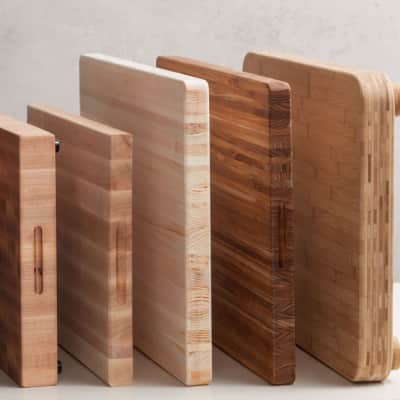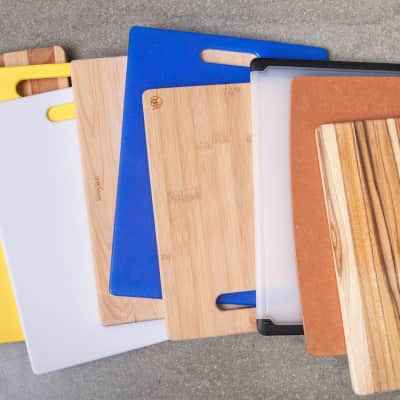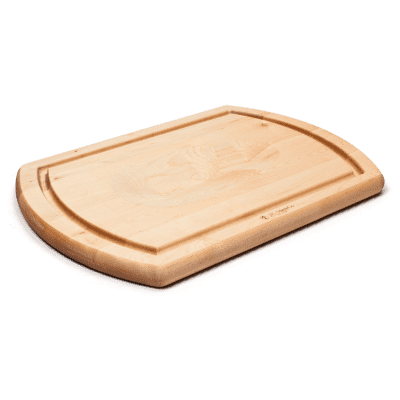Over the years we’ve tested hundreds of cutting boards here at America’s Test Kitchen. And while we’ve learned a lot during those testings, two things stand out.
Which Cutting Board Is Right for You?
Published July 23, 2020.

First: Do not buy a glass or metal cutting board. Please, please, please, for the love of all that is good and holy, don’t buy these boards. We know they’re pretty, but they will roll the edges of your blades within a few cuts, rendering them dull. Why would you do this to your knives? What did they ever do to you?
Second: There is no one "best" board for all cooks. The choice of a cutting board is as personal as the choice of a knife—only you can say which board is right for you and your kitchen. (As long as it’s not metal or glass!) Below we share some tips on how to determine the best choice for you.
Counter Space and Use
One of the most important considerations when choosing a board is counter space. For most cooks, we recommend getting the biggest board your counter or kitchen table can comfortably accommodate. Bigger boards are the most versatile and useful, as they provide more room for performing tasks of all sizes, whether it’s dicing an onion or breaking down a chicken. Professional cooks also like them because they allow you to keep all your prepped ingredients in one place: on the board itself. If you have enough counter space, invest in a large board measuring at least 15 by 20 inches.
But not everyone has the luxury of lots of counter space. If your kitchen is small, get a more compact board—a small cutting board and/or a bar board. A small cutting board can still handle many prep tasks, including dicing carrots, trimming broccoli, mincing herbs, or even pounding chicken breasts.

It’s important to think about how you intend to use the board, after all. If you know you’re never going to spatchcock a turkey or prep 5 pounds of Swiss chard at a time, you might be fine with a small board. And if you’re more of a snacker than a cook, you might appreciate a bar board, which will give you just enough space to peel and slice an apple, cut up some cheese, or prepare a sandwich.
If you have the space and can afford it, of course, we recommend getting a few boards of different sizes—large and small—so you don’t have to pull out the big guns when you just need to slice an apple.
Budget
Cutting boards are available at every price point. In general, the bigger the board, the more expensive it is. Wood and bamboo boards are also generally more expensive than plastic boards of the same size, as they require more expensive materials and craftsmanship or manufacturing.

Material: Wood and Bamboo vs. Plastic
Money doesn’t necessarily get you a “better” board, though. Contrary to what many folks will tell you, we have reason to believe that in practice, there is very little difference in how wood and plastic boards perform. In preliminary tests using robots to simulate long-term use, we found that wood boards and plastic boards dulled knives at about the same rates. In the test kitchen, we’ve used both types of boards for years. If anyone would notice a difference, it would be our test cooks, who use them for nearly 8 hours a day, five days a week—and we’ve never had a test cook complain that their knives were being ruined by our favorite plastic boards.
That said, wood, bamboo, and plastic boards all look, feel, and sound very different. Many folks prefer the aesthetics and action of a wood or bamboo board—and some are very beautiful indeed. Others don’t care much what their boards look or sound like; after all, a board is first and foremost a tool. Preferences are personal, but they also depend on nonaesthetic factors.
Simply put, wood and bamboo cutting boards take a little more work to use, clean, and maintain than plastic boards do. For one thing, wood and bamboo boards are usually heavier than plastic boards of comparable size. Our favorite wood cutting board weighs 10 pounds and our favorite plastic board weighs about 5. If portability is your greatest concern, go with plastic.
Wood and bamboo boards also must be seasoned with oil before use, washed by hand and carefully dried, and maintained with regular applications of oil to keep them from cracking or warping. Some folks love these tasks—they find that all that TLC makes them feel closer to their boards, and they enjoy the soothing routines of cutting board maintenance. If you like sharpening your knives or restoring old cast-iron cookware, you’ll probably love having a wood or bamboo board. As a bonus, our favorite wood cutting board is actually fairly low-maintenance, so unless you’re really putting your board to restaurant-volume use, you probably won’t have to oil it very often anyway.
Plastic boards are the ultimate convenience product. You can hand-wash them if you like; because they’re so light, they’re easier to maneuver off the counter and around a sink. But you can also throw them in the dishwasher—a boon if you hate scrubbing dishes or are squeamish about handling the board after you’ve prepped poultry, fish, or meat. (Don’t worry, wood cutting board fans—the U.S. Food and Drug Administration’s Food Safety and Inspection Service assures us that as long as you scrub your boards thoroughly with soap and hot water, there’s no reason to believe that they’re any less hygienic or safe to use than plastic.)
Even large plastic cutting boards can fit in the dishwasher if you’re strategic about their placement. Our pro tip: Take out your dishwasher’s silverware drawer to help get your board in.

Durability and Abuse
Durability is also worth considering when buying a board. When properly maintained, a good wood or bamboo cutting board can last a lifetime; for many, this longevity more than justifies these boards’ higher cost.
If treated with care, plastic boards can be almost as durable, but they tend to warp and crack over the years. Because they’re less expensive, though, they’re also easier to replace. If you do a lot of high-force tasks such as butchering at home—especially if you use a cleaver, which can crack or split any board, wood or plastic—we’d recommend sticking to a plastic board, as your wallet will be happier if you do need to get a new board from time to time.
Height
Believe it or not, your height can also be a factor when choosing a board. Average-height folks are best off with simple reversible boards that have no feet or small feet. If you’re tall, though, you might want to invest in a thick board with large feet, such as our runner-up heavy-duty wood cutting board, as it will rise higher above the counter than a footless board, allowing you to chop without hunching over quite as much.
We hope that this guide has given you the information you need to make a good choice about the board that’s best for you. Care for it properly and it will serve you well for years to come.





